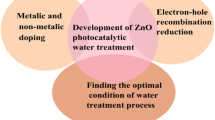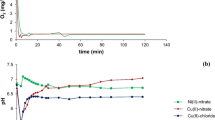Abstract
Oxidative degradation of aqueous organic contaminants 2,4-dichlorophenol (2,4-DCP) using ethylenediaminetetraacetic acid (EDTA)-enhanced bimetallic Cu–Fe system in the presence of dissolved oxygen was investigated. The proposed process was applied for the pH range of 3~7 with the degradation efficiency of 2,4-DCP and EDTA varying within 10 %, and achieved at 100 % degradation of 40 mg L−1 2,4-DCP in 1 h, at the initial pH of 3, 25 g L−1 of bimetallic Fe–Cu powder (WCu/WFe = 0.01289) and initial EDTA of 0.57 mM. However, the removal efficiency of 2,4-DCP in control tests were 7.52 % (Cu–Fe/O2 system) and 84.32 % (EDTA-enhanced Fe/O2 process), respectively, after 3 h, reaction. The proposed main mechanism, involves the in situ generation of H2O2 by the electron transfer from Fe0 to O2 which was enhanced by ethylenediaminetetraacetic acid (EDTA), and the in situ generation of ·OH via advanced oxidation reaction. Accordingly, 2,4-DCP was attacked by ·OH to achieve complete dechlorination and low molecular weight organic acids, even mineralized. Systematic studies on the effects of initial EDTA and 2,4-DCP concentration, Cu–Fe dosing, Cu content, and pH revealed that these effects need to be optimized to avoid the excessive consumption of ·OH and new EDTA and heavy metal Cu pollution.







Similar content being viewed by others
References
Albadarin AB, Mangwandi C, Al-Muhtaseb AH, Walker GM, Allen SJ, Ahmad MNM (2012) Kinetic and thermodynamics of chromium ions adsorption onto low-cost dolomite adsorbent. Chem Eng J 179:193–202
Andreozzi R, Somma ID, Marotta R, Pinto G, Pollio A, Spasiano D (2011) Oxidation of 2,4-dichlorophenol and 3,4-dichlorophenol by means of Fe(III)-homogeneous photocatalysis and algal toxicity assessment of the treated solutions. Water Res 45:2038–2048
Arslan-Alaton I, Ayten N, Olmez-Hanci T (2010) Hoto-Fenton-like treatment of the commercially important H-acid: process optimization by factorial design and effects of photocatalytic treatment on activated sludge inhibition. Appl Catal B 96:208–217
Bader H, Sturzenegger V, Hoigné J (1988) Photometric method for the determination of low concentrations of hydrogen peroxide by the peroxidase catalyzed oxidation of N, N-diethyl-p-phenylenediamine (DPD). Water Res 22:1109–1115
Bekbolet M, Cınar Z, Kılıc M, Uyguner CS, Minero C, Pelizzetti E (2009) Photocatalytic oxidation of dinitronaphthalenes: theory and experiment. Chemosphere 75:1008–1014
Bransfield SJ, Cwiertny DM, Roberts AL, Fairbrother DH (2006) Influence of copper loading and surface coverage on the reactivity of granular iron toward 1,1,1-trichloroethane. Environ Sci Technol 40:1485–1490
Cooper GS, Jones S (2008) Pentachlorophenol and cancer risk: focusing the lens on specific chlorophenols and contaminants. Environ Health Persp 116:1001–1008
Dean JA (1985) Lange’s Handbook of Chemistry, 13th edn. McGraw Hill, New York
Doong RA, Lai YL (2006) Effect of metal ions and humic acid on the dechlorination of tetrachloroethylene by zerovalent iron. Chemosphere 64:371–378
Englehardt JD, Meeroff DE, Echegoyen L, Deng Y, Raymo FM, Shibata T (2007) Oxidation of aqueous EDTA and associated organics and coprecipitation of inorganics by ambient iron-mediated aeration. Environ Sci Technol 41:270–276
Fan JH, Ma LM (2009) The pretreatment by the Fe-Cu process for enhancing biological degradability of the mixed wastewater. J Hazard Mater 164:1392–1397
González LF, Sarria V, Sánchez OF (2010) Degradation of chlorophenols by sequential biological-advanced oxidative process using Trametes pubescens and TiO2/UV. Bioresource Technol 101:3493–3499
Huang JY, Liao WP, Lai SM (2013) Removal of 2,4-dichlorophenol and pentachlorophenol from aqueous media by electrochemical process. Environ Earth Sci 68:2281–2288
Joo SH, Feitz AJ, Waite TD (2004) Oxidative degradation of the carbothioate herbicide, molinate, using nanoscale zero-valent iron. Environ Sci Technol 38:2243–2247
Karcia A, Alatonb IA, Hancib TO, Bekböleta M, Photoch J (2012) Transformation of 2,4-dichlorophenol by H2O2/UV-C, Fenton and photo-Fenton processes: oxidation products and toxicity evolution. J Photoch Photobio A 230:65–73
Keenan C, Sedlak D (2008a) Factors affecting the yield of oxidants from the reaction of nanoparticulate zero-valent iron and oxygen. Environ Sci Technol 42:1262–1267
Keenan C, Sedlak D (2008b) Ligand-enhanced reactive oxidant generation by nanoparticulate zero-valent iron and oxygen. Environ Sci Technol 42:6936–6941
Kim JK, Metcalfe IS (2007) Investigation of the generation of hydroxyl radicals and their oxidative role in the presence of heterogeneous copper catalysts. Chemosphere 69:689–696
Lee YJ, Han H, Kim SH, Yang JW (2009) Combination of electrokinetic separation and electrochemical oxidation for acid dye removal from soil. Sep Sci Technol 44:2455–2469
Li X, Zeng GM, Huang JH, Zhang DM, Shi LJ, He SB, Ruan M (2011) Imultaneous removal of cadmium ions and phenol with MEUF using SDS and mixed surfactants. Desalination 276:136–141
Liu LF, Zhang PH, Yang FL (2010) Adsorptive removal of 2,4-DCP from water by fresh or regenerated chitosan/ACF/TiO2 membrane. Sep Purif Technol 70:354–361
Liu LF, Chen F, Yang FL, Chen YS, Crittenden J (2012) Photocatalytic degradation of 2,4-dichlorophenol using nanoscale Fe/TiO2. Chem Eng J 181–182:189–195
Liu X, Fan JH, Ma LM (2013a) Oxidative degradation of EDTA in aqueous solution by the bimetallic Fe–Cu. Water Air Soil Poll 224:1583
Liu X, Fan JH, Ma LM (2013b) Elimination of EDTA in aqueous solution by bimetallic Fe-Cu process. Adv Mater Res 779–780:21–25
Lu R, Ai ZH, Li JP, Zheng Z, Li Q, Zhang LZ (2007) Synthesis and characterization of Fe–Fe2O3 core-shell nanowires and nanonecklaces. Cryst Growth Des 7:459–464
Luna AJ, Filho OC, Machulek A, Nascimento CAO (2012) Nascimento, photo-Fenton oxidation of phenol and organochlorides (2,4-DCP and 2,4-D) in aqueous alkaline medium with high chloride concentration. J Environ Manage 111:10–17
Ma LM, Zhang WX (2008) Enhanced biological treatment of industrial wastewater with bimetallic zero-valent iron. Environ Sci Technol 42:5384–5389
Maketon W, Zenner C, Ogden K (2008) Removal efficiency and binding mechanisms of copper and copper–edta complexes using polyethyleneimine. Environ Sci Technol 42:2124–2129
Mantzavinos D (2003) Removal of cinnamic acid derivatives from aqueous effluents by Fenton and Fenton-like processes as an alternative to direct biological treatment. Water Air Soil Poll: Focus 3:211–221
Marc PT, Verónica GM, Miguel AB, Jaime G, Santiago E (2004) Degradation of chlorophenols by means of advanced oxidation processes: a general review. Appl Catal B 47:219–256
Methatham T, Lu MC, Ratanatamskul C (2011) Removal of 2,4-dichlorophenol as herbicide’s by-product by Fenton’s reagent combined with an electrochemical system. Desalin Water Treat 320:42–48
Módenes AN, Quiñones FRE, Trigueros DEG, Lavarda FL, Colombo A, Mora ND (2011) Kinetic, equilibrium adsorption of Cu(II) and Cd(II) ions on Eichhornia crassipes in single and binary systems. Chem Eng J 168:44–51
Muangthai I, Ratanatamsakul C, Lu MC (2010) Removal of 2,4-dichlorophenol by fluidized-bed Fenton process. Sustain Environ Res 20:325–331
Noradoun C, Cheng I (2005) EDTA degradation induced by oxygen activation in a zerovalent iron/air/water system. Environ Sci Technol 39:158–163
Oliveira R, Almeida MF, Santos L, Madeira LM (2006) Experimental design of 2, 4-dichlorophenol oxidation by Fenton’s reaction. Ind Eng Chem Res 45:1266–1276
Oller I, Malato S, Perez JAS (2011) Combination of advanced oxidation processes and biological treatments for wastewater decontamination—a review. Sci Total Environ 409:4141–4166
Olmez-Hanci T, Arslan-Alaton I, Basar G (2011) Multivariate analysis of anionic, cationic and nonionic textile surfactant degradation with the H2O2/UV-C process by using the capabilities of response surface methodology. J Hazard Mater 185:193–203
Ozawa T, Hanaki A (1991) The first ESR spin-trapping evidence for the formation of hydroxyl radical from the reaction of copper(II)complex with hydrogen peroxide in aqueous solution. Chem Commun 5:330–332
Seibig S, Eldik RV (1997) Kinetics of [FeII(edta)] oxidation by molecular oxygen revisited. New evidence for a multistep mechanism. Inorg Chem 36:4115–4120
Shih YJ, Su HT, Huang YH (2013) Photoelectro-Fenton mineralization of phenol through optimization of ferrous regeneration. Environ Sci Pollut Res 20:6184–6190
Song QJ, Niu T, Wang HJ (2008) Theoretical study of the reaction of 2,4-dichlorophenol with O2. J Mol Struc-Theochem 861:27–32
Tang WZ, Huang C (1996) 2, 4-dichlorophenol oxidation kinetics by Fenton’s reagent. Environ Technol 17:1371–1378
Velosa ACD, Nogueira RFP (2013) 2,4-dichlorophenoxyacetic acid (2,4-D) degradation promoted by nanoparticulate zerovalent iron (nZVI) in aerobic suspensions. J Environ Manage 121:72–79
Wang Y, Shen ZY, Li Y, Niu JF (2010) Electrochemical properties of the erbium-chitosan- fluorine–modified PbO2 electrode for the degradation of 2,4-dichlorophenol in aqueous solution. Chemosphere 79:987–996
Wang L, Zhang J, Zhao R, Zhang CL, Li C, Li Y (2011) Adsorption of 2,4-dichlorophenol on Mn-modified activated carbon prepared from Polygonum orientale Linn. Desalination 26:175–181
Xu LJ, Wang JL (2012) Fenton-like degradation of 2,4-dichlorophenol using Fe3O4 magnetic nanoparticles. Appl Catal B-Environ 123–124:117–126
Yin LF, Shen ZY, Niu JF, Chen J, Duan YP (2010) Degradation of pentachlorophenol and 2, 4-dichlorophenol by sequential visible-light driven photocatalysis and laccase catalysis. Environ Sci Technol 44:9117–9122
Zhou T, Lu XH, Wang J, Wong FS, Li YZ (2009a) Rapid decolorization and mineralization of simulated textile wastewater in a heterogeneous Fenton like system with/without external energy. J Hazard Mater 165:193–199
Zhou T, Lim T, Lu X, Li Y, Wong F (2009b) Simultaneous degradation of 4CP and EDTA in a heterogeneous ultrasound/Fenton like system at ambient circumstance. Sep Purif Technol 68:367–374
Zhou T, Li YZ, Wong FS, Lu XH (2010) Enhanced degradation of 2,4-dichlorophenol by ultrasound in a new Fenton like system (Fe/EDTA) at ambient circumstance. Ultrason Sonochem 15:782–790
Zhou HY, Sun Q, Wang X, Wang LL, Chen J, Zhang JD, Lu XH (2014) Removal of 2,4-dichlorophenol from contaminated soil by a heterogeneous ZVI/EDTA/Air Fenton-like system. Sep Purif Technol 132:346–353
Zhu BW, Lim TT, Feng J (2008) Influences of amphiphiles on dechlorination of a trichlorobenzene by nanoscale Pd/Fe: adsorption, reaction kinetics, and interfacial interactions. Environ Sci Technol 42:4513–4519
Acknowledgments
This study has been financially supported by National Natural Science Foundation of China (no. 51108330) and State Key Laboratory of Pollution Control and Resource Reuse Foundation (no. PCRRY11005).
Author information
Authors and Affiliations
Corresponding author
Additional information
Responsible editor: Philippe Garrigues
Rights and permissions
About this article
Cite this article
Liu, X., Fan, JH. & Ma, LM. Simultaneously degradation of 2,4-Dichlorophenol and EDTA in aqueous solution by the bimetallic Cu–Fe/O2 system. Environ Sci Pollut Res 22, 1186–1198 (2015). https://doi.org/10.1007/s11356-014-3372-z
Received:
Accepted:
Published:
Issue Date:
DOI: https://doi.org/10.1007/s11356-014-3372-z




